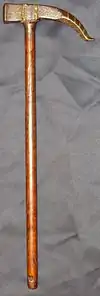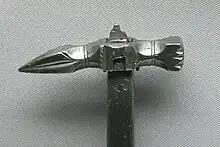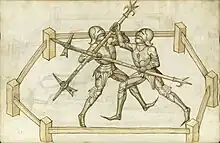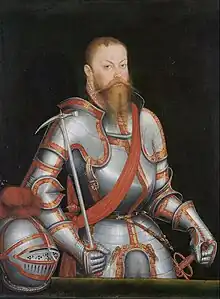| War hammer | |
|---|---|
 Indo-Persian war hammer, heavy iron head with a hammer in front, a 4.5-inch (11 cm) curved spike on the other side, cut channel decorations, hard wood shaft | |
| Type | Impact weapon or polearm |
| Place of origin | Europe and the Middle East |
| Service history | |
| In service | Medieval |
| Specifications | |
| Head type | Hammer, sometimes an additional spike |
| Haft type | One or two handed |
A war hammer (French: martel-de-fer, "iron hammer") is a weapon that was used by both foot soldiers and cavalry. It is a very old weapon and gave its name, owing to its constant use, to Judah Maccabee, a 2nd-century BC Jewish rebel, and to Charles Martel, one of the rulers of France. In the 15th and 16th centuries, the war hammer became an elaborately decorated and handsome weapon.[1]
The war hammer was a popular weapon in the late medieval period. It became somewhat of a necessity in combat when armor became so strong that swords and axes were no longer able to pierce and ricocheted upon impact. The war hammer could inflict significant damage on the enemy through their heavy impact without the need to pierce the armor.[2]
Design

A war hammer consists of a handle and a head. The length of the handle may vary, the longest being roughly equivalent to that of a halberd (five to six feet or 1.5 to 1.8 meters), and the shortest about the same as that of a mace (two to three feet or 60 to 90 centimeters). Long war hammers were pole weapons, or polearms, meant for use on foot, whereas short ones were used from horseback.[3]
War hammers, especially when mounted on a pole, could in some cases transmit their impact through helmets and cause concussions. Later war hammers often had a spike on one side of the head, making them more versatile weapons.
The spike end could be used for grappling the target's armor, reins, or shield. If against mounted opponents, the weapon could be directed at the legs of a horse, toppling the armored foe to the ground where they could be more easily attacked. The blunt side of a war hammer was usually used first to knock out and stun an enemy and, once they were on the ground, reversed to punch a hole through the helmet and deliver the coup de grâce. A powerful swing from a war hammer can hit its target with a force of several hundred kilograms per square millimeter. This is the same penetrating force as a rifle bullet.[4]
Maul
A maul is a long-handled hammer with a heavy head, of wood, lead, iron, or steel. It is similar in appearance and function to a modern sledgehammer, it is sometimes shown as having a spear-like spike on the fore-end of the haft.
The use of the maul as a weapon seems to date from the later 14th century. During the Harelle of 1382, rebellious citizens of Paris seized 3000 mauls (French: maillet) from the city armory, leading to the rebels' being dubbed Maillotins.[5] Later in the same year, Froissart records French men-at-arms using mauls at the Battle of Roosebeke, demonstrating that they were not simply weapons of the lower classes.[6]
A particular use of the maul was by archers in the 15th and 16th centuries. At the Battle of Agincourt, English longbowmen are recorded as using lead mauls, initially as a tool to drive in stakes but later as improvised weapons.[7] Other references during the century (for example, in Charles the Bold's 1472 Ordinance) suggest continued use.[8] They are recorded as a weapon of Tudor archers as late as 1562.[7]
History
Full-fledged warhammers would be developed in the middle of the 14th century. Their development was a direct response to the increasing quantity and quality of plate armor on the European battlefield. French foot soldiers used fully developed warhammers with thrusting tips, flanges on the side, and a rudimentary one as early as 1395, known as "Picoise". These originally single-handed warhammers would develop into the longer two-handed pole hammers, which were not only common on European battlefields but also a prominent weapon in duels, especially armored ones, be it in the context of a tournament or judicial duel.
In the context of a duel, the pole hammer was viewed as a subtype of the pole-axe, as most period fencing manuals simply referred to them as "axes" (German: (Mord)Axt, Italian: (Azza). Pole-hammers made for duels often featured a rondel-shaped guard to protect the forward hand and a spike at its rear, allowing for more flexible usage. In some cases, the pole-hammer possessed additional hooks at the rear end to support the binding of enemy weapons and limbs. The hammer surface of earlier types used to be flat, but by the 15th century, there was a tendency to divide the hammerhead into four or three diamond-shaped tips. This was done to increase the penetration ability of the hammer. According to Austrian army officer and weapon expert Wendelin Boeheim, these changes did not bring the desired results and were continued only for aesthetic reasons. In some cases, the hammer surface featured the monogram of its owner, allowing for the identification of his victims on the battlefield.
From the 15th century onward, shorter warhammers were used as cavalry weapons. The nobility initially rejected them due to their origin from a commoner's tool but were forced to adopt them out of pragmatism. This notion would later shift in the opposite

direction. In Landsknecht armies, cavalry commanders, known as Rottmeister (lit. packmaster), would carry a warhammer as both a weapon and an insignia of rank, to the extent that these hammers became known as "Rottmeister hammers" or "packmaster hammers." A similar

connotation existed in the eastern parts of central Europe (Poland-Lithuania/Hungary), where hammers would develop into status symbols of the lower nobility and become the most revered weapons, right after the saber. According to Andrzej Kitowicz, a Polish aristocrat, would not leave his house without his saber and his warhammer, which could also be used as a walking stick. These late Central European hammers can be divided into three subtypes: the Czekan, which was a type of warhammer with a flattened square-shaped or hexagonal surface and a bearded axe blade on the back; the Nadziak, which was more of a classic warhammer, again with a flattened square-shaped or hexagonal surface and a beak at the back; and the Ogbur, which was similar to the Nadziak but with an S-shaped or strictly curved beak on the back. All of these types had in common that their staffs were made from hard wood, the shaft would often extend over the socket, and they usually did not possess a thrusting tip.
While the warhammer largely dropped out of usage in most parts of Europe, it remained popular in Poland and Hungary until the first half of the 18th century.
Gallery
 Maurice, Elector of Saxony wields a war hammer on a posthumous portrait
Maurice, Elector of Saxony wields a war hammer on a posthumous portrait Knight with war hammer (painting by Paolo Uccello)
Knight with war hammer (painting by Paolo Uccello) War hammer.
War hammer. War hammer exhibited in the Deutsches Historisches Museum, Berlin.
War hammer exhibited in the Deutsches Historisches Museum, Berlin. Indian war hammer, 19th century, hard wood shaft with full length metal strip for re-enforcement, silver koftgari decoration.
Indian war hammer, 19th century, hard wood shaft with full length metal strip for re-enforcement, silver koftgari decoration.
See also
References
- ↑ Sargeaunt, Bertram Edward (1908). Weapons, a brief discourse on hand-weapons other than fire-arms. London, H. Rees. p. 11.
- ↑ "Medieval WarHammer". Medieval Chronicles. 2015-09-18. Retrieved 2022-11-14.
- ↑ warhammer, medievalchronicles.com
- ↑ "Medieval Weapons: War Hammer. Types of War Hammers, Facts, History". Medieval Britain. 2020-01-13. Retrieved 2022-11-14.
- ↑ Tuchman, Barbara (1979). A distant Mirror. London: Penguin. p. 380. ISBN 0140054073.
- ↑ Bourchier, John (1523). Macaulay, G.C. (ed.). Chronicles of Froissart (1924 ed.). London. p. 288. Archived from the original on 2012-02-23.
- 1 2 Strickland & Hardy 2005, p. 337.
- ↑ Strickland & Hardy 2005, p. 364.
- Strickland, Matthew; Hardy, Robert (2005). The Great Warbow. Stroud: Sutton. ISBN 0750931671.